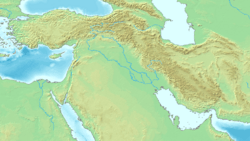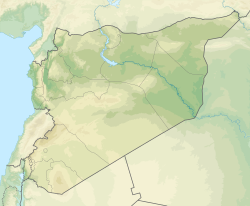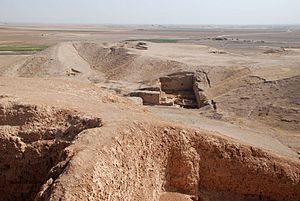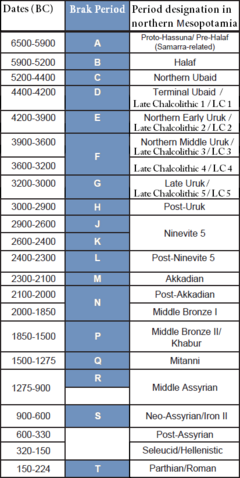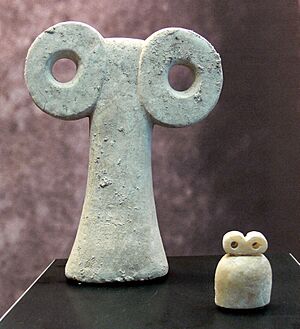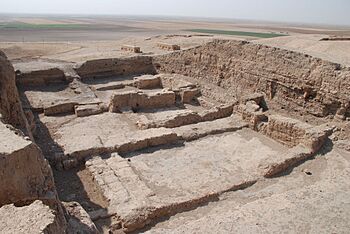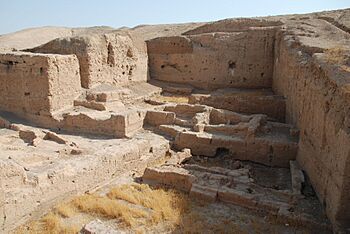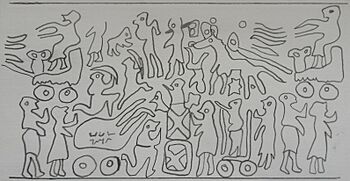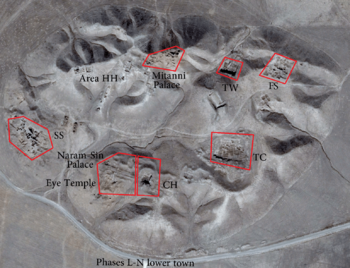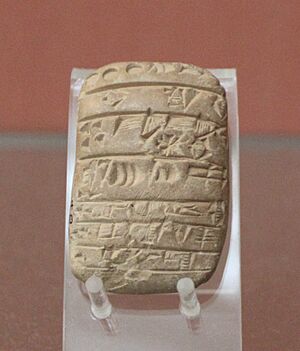Tell Brak facts for kids
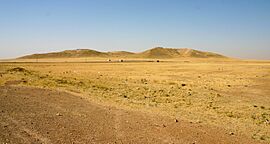
Tell Brak as seen from a distance with several excavation areas visible
|
|
| Alternative name | Nagar, Nawar |
|---|---|
| Location | Al-Hasakah Governorate, Syria |
| Coordinates | 36°40′03.42″N 41°03′31.12″E / 36.6676167°N 41.0586444°E |
| Type | Settlement |
| Area | 60 hectares (150 acres). |
| Height | 40 metres (130 ft). |
| History | |
| Periods | Neolithic, Bronze Age |
| Cultures | Halaf culture, Northern Ubaid, Uruk, Kish civilization, Hurrian |
| Site notes | |
| Excavation dates | 1937–1938, 1976–2011 |
| Archaeologists | Max Mallowan, David Oates, Joan Oates |
| Public access | yes |
| Website | tellbrak.mcdonald.cam.ac.uk |
Tell Brak was an important ancient city in Syria. Its ruins form a large mound, called a tell, in the Upper Khabur region. It is close to the modern village of Tell Brak. The city's original name is not known. Later, in the third millennium BC, it was called Nagar, and even later, Nawar.
Tell Brak started as a small village around 7000 BC. By 4000 BC, it grew into one of the largest cities in Upper Mesopotamia. It traded and shared ideas with cultures from southern Mesopotamia. The city became smaller around 3000 BC, after the Uruk period ended. But it grew big again around 2600 BC, when it was known as Nagar. At this time, it was the capital of a kingdom that controlled the Khabur river valley.
Nagar was destroyed around 2300 BC. It then came under the rule of the Akkadian Empire. After that, it was an independent Hurrian city-state. It became smaller again around 2000 BC. Nagar became important once more by the 19th century BC, ruled by different powers. Around 1500 BC, Tell Brak was a key city for the Mitanni empire. It was destroyed by Assyria around 1300 BC. The city never fully recovered its past glory. It remained a small settlement, sometimes abandoned, until it disappeared from records around the early Abbasid era.
Many different groups of people lived in Tell Brak. These included the Halafians, Semites, and Hurrians. Tell Brak was a religious center from its very beginning. Its famous Eye Temple is special in the Fertile Crescent. The city's main goddess, Belet Nagar, was worshipped throughout the Khabur region. This made Tell Brak a place where people went on religious journeys. The culture of Tell Brak was shaped by the many civilizations that lived there. It was known for its unique seal designs, horses and donkeys, and glass. When it was independent, the city was ruled by local leaders or a king. Tell Brak was a busy trade center because it was located between Anatolia, the Levant, and southern Mesopotamia. Archaeologists started digging there in 1937. Regular excavations took place from 1979 to 2011, stopping due to the Syrian Civil War.
Contents
What's in a Name?
We don't know the city's first name. "Tell Brak" is the name of the mound today. There's a dried lake nearby called "Khatuniah." Roman maps from long ago called it "Lacus Beberaci," meaning "the lake of Brak." This suggests the lake was named after Tell Brak, which was the closest camp. So, "Brak" might be a very old name for the area.
In the third millennium BC, the city was known as "Nagar." This name might come from a Semitic word meaning "a place where things are grown." The name "Nagar" stopped being used after the Old Babylonian period. However, the city continued to exist as "Nawar" under the Hurrian state of Mitanni. Kings of Urkesh in the third millennium BC called themselves "King of Urkesh and Nawar." Most experts think Nagar and Nawar are the same city. But some, like Jesper Eidem, are not so sure. They think Nawar might have been a different city closer to Urkesh.
A City Through Time
Tell Brak has a very long history. It changed a lot over thousands of years.
Early Beginnings
The first small settlement at Tell Brak dates back to around 6500 BC. This was during the early Halaf culture. Many items from this time, including special Halaf pottery, have been found.
Later, the Halaf culture changed into the Northern Ubaid culture. Many Ubaid tools and pottery were found at Tell Brak. Digs showed that Tell Brak grew into a city even earlier than famous southern Mesopotamian cities like Uruk.
The First Big City
Growing into a City
In southern Mesopotamia, the Ubaid culture became the Uruk period. People from the southern Uruk period expanded their civilization through trade and military power. In Northern Mesopotamia, this time is called the Late Chalcolithic or Northern Uruk period. During this time, Tell Brak started to grow much larger.
Around 4200-3900 BC, Tell Brak built city walls. It also expanded beyond the main mound, forming a lower town. This made it an early city, covering about 55 hectares.
Archaeologists found a huge building in an area called TW. It had very thick walls and a basalt doorway. A street paved with pottery pieces led to the city's northern entrance. This building covered a large area and was very deep.
The Eye Temple
Around 3800-3600 BC, Tell Brak continued to grow. It reached a size of 130 hectares. Archaeologists found four mass graves, mostly of young people, outside the main mound. This suggests that as the city grew, there might have been social problems or more wars.
During this time, the famous Eye Temple was built. It was named for the thousands of small alabaster "Eye idols" found inside. These idols were also found in the TW area.
Later, from 3600-3000 BC, Tell Brak had more contact with Southern Mesopotamia. A colony of Uruk people was set up in the city. When the Uruk culture ended around 3000 BC, this colony was left empty and carefully leveled by its people.
After this, the city became smaller again. But there is still proof of trade with southern Mesopotamia.
The Bronze Age
The Kingdom of Nagar
|
Nagar
|
|
|---|---|
| c. 2600 BC–c. 2300 BC | |
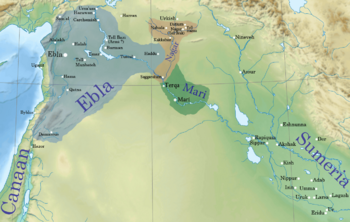
The kingdom of Nagar c. 2340 BC
|
|
| Capital | Nagar |
| Common languages | Nagarite |
| Religion | Mesopotamian |
| Government | Monarchy |
| Historical era | Bronze Age |
|
• Established
|
c. 2600 BC |
|
• Disestablished
|
c. 2300 BC |
Around 2600 BC, a large government building was built. The city grew outside the main mound again. This growth is linked to the Kish civilization. The city was now called "Nagar." One important building from this kingdom is called the "Brak Oval." It had a curved outer wall, similar to a temple in central Mesopotamia.
We learn about Nagar from ancient texts found in Mari and Nabada. But the most important information comes from the archives of Ebla. Most texts mention the ruler of Nagar by their title, "En," but not their name. However, one text from Ebla mentions Mara-Il, a king of Nagar. He is the only known ruler of Nagar before the Akkadian empire.
At its peak, Nagar controlled most of the southwestern Khabur Basin. It was as powerful as the states of Ebla and Mari. The kingdom included at least 17 smaller cities. Nagar was part of a large network of alliances and conflicts with Ebla. One text from Ebla describes Ebla's king winning a battle against Nagar. But a few years later, they made a peace treaty. There was even a royal marriage between Princess Tagrish-Damu of Ebla and Prince Ultum-Huhu of Nagar.
Nagar was defeated by Mari. This blocked trade routes between Ebla and southern Mesopotamia. Later, Ebla's king Isar-Damu formed an alliance with Nagar and Kish against Mari. Their combined armies won a battle near Terqa. Ebla was destroyed about three years after this battle. Soon after, Nagar was also destroyed around 2300 BC. Large parts of the city were burned. This destruction is thought to be caused by either Mari or Sargon of Akkad.
Akkadian Rule

After its destruction, the Akkadian empire rebuilt Nagar. It became a center for their local government. The city covered the entire mound and a lower town. Two public buildings were built during the early Akkadian period. One building might have been a place for travelers to stay, as it was near the northern gate. Its temple was dedicated to Šamagan, the god of steppe animals. Early Akkadian kings had internal problems, and Tell Brak was left empty for a while before the reign of Naram-Sin. This might have been due to a dry period that turned the region into a desert.
The fall of Nagar's kingdom created a power gap. The Hurrians, who were mainly in Urkesh, took control of the region. Tell Brak was known as "Nawar" to the Hurrians. Kings of Urkesh called themselves "King of Urkesh and Nawar."
The Akkadians under Naram-Sin took strong control of Nagar. The most important Akkadian building is called the "Palace of Naram-Sin." It was more like a fortress for storing goods than a home for the king. This palace was burned during Naram-Sin's rule, possibly by an attack from the Lullubi people. The city was burned again around 2193 BC, near the end of the Akkadian period, probably by the Gutians.
After the Akkadians
When the Akkadian Empire fell around 2154 BC, Nagar became the center of an independent Hurrian kingdom. A seal was found with the name of King Talpus-Atili of Nagar.
Some people thought Tell Brak was controlled by the Ur III empire. But this idea is now rejected. There is proof that the Hurrians rebuilt Naram-Sin's palace. The city became smaller, with public buildings left empty and the lower town abandoned. But archaeologists found evidence that people continued to live in the city, even if it was much smaller.
Later Periods
Mari and Mitanni
Around 1820-1550 BC, Nagar was a busy city. It came under the rule of Mari. Yahdun-Lim of Mari won an important victory against Shamshi-Adad I of Assyria here. Nagar lost its importance and was later ruled by Kahat in the 18th century BC.
During the Mitanni period, Tell Brak was an important trade city. A two-story palace and a temple were built around 1500 BC. The city was destroyed between 1300 and 1275 BC. This happened in two stages, first by the Assyrian king Adad-Nirari I, then by his successor Shalmaneser I.
Iron Age and Beyond
After the Mitannian city was destroyed, there is little evidence of people living on the main mound. However, small villages existed in the lower town during the Assyrian periods. Ruins of a Hellenistic settlement were found nearby. There were also some pottery pieces from the Parthian-Roman and Byzantine-Sasanian periods. A fortified building was built in the lower town around 500 AD. The last time people lived at the site was during the early Abbasid Caliphate. A canal was built then to bring water to the town from the nearby Jaghjagh River.
People and Culture
Who Lived There?
The Halafians were the first people in northern Syria. They later adopted the southern Ubaidian culture. People from southern Mesopotamia moved to Tell Brak later, forming a mixed society. The Uruk colony was abandoned by its people around 3000 BC. This left Tell Brak a much smaller city. The people of the pre-Akkadian kingdom were Semitic. They spoke their own East Semitic language, similar to the one used in Ebla and Mari.
No Hurrian names are found from before the Akkadian period. But the name of Prince Ultum-Huhu is hard to understand as Semitic. During the Akkadian period, both Semitic and Hurrian names were recorded. The Hurrians seemed to move into the region when the pre-Akkadian kingdom fell. After the Akkadian period, Tell Brak had a strong Hurrian presence. There were Hurrian rulers, but Amorite tribes also lived in the area. Tell Brak was a center of the Hurrian-Mitannian empire, where Hurrian was the official language. However, Akkadian was used for international communication. This is shown by tablets found at Tell Brak from both the post-Akkadian and Mitannian times.
Beliefs and Religion
The finds in the Eye Temple show that Tell Brak is one of the earliest places in northern Mesopotamia with organized religion. We don't know which god the Eye Temple was for. The "Eyes" figurines seem to be gifts to this unknown god. The temple was probably for the Sumerian goddess Innana or the Semitic goddess Ishtar. Some think the "Eyes" figurines showed an all-seeing female god.
During the pre-Akkadian kingdom, Hazna was an old religious center. It served as a place of pilgrimage for Nagar. The Eye Temple was still used, but as a small shrine. The goddess Belet Nagar became the most important god of the kingdom. Her temple has not been found, but it might be under the Mitannian palace. The Eblaite god Kura was also worshipped in Nagar. Kings also visited the temple of the Semitic god Dagon in Tuttul. During the Akkadian period, a temple was dedicated to the Sumerian god Shakkan. He was the god of animals and the countryside. Tell Brak was an important Hurrian religious center. The temple of Belet Nagar remained important in the region until around 2000 BC.
Art and Life
Northern Mesopotamia developed its own unique culture from 4000–3500 BC. This time was known for its focus on holy places, like the Eye Temple in Tell Brak. A building in area TW had wooden panels and the earliest known semi-columned front. This style would later be seen in temples.
After 3200 BC, northern Mesopotamia was strongly influenced by the southern Uruk culture. This affected Tell Brak's buildings and how it was run. The Uruk influence is clear in the Eye Temple, which had southern elements like cone mosaics. The Uruk people seemed to live peacefully in Tell Brak. Trade deals were often made during feasts. Digs in area TW showed that feasting was a big part of local life. They found cooking areas, lots of grain, animal bones, and ovens. Among the Uruk items found was a standard text for educated scribes. This shows that a common education system existed across Syria and Mesopotamia.
The pre-Akkadian kingdom was famous for its acrobats. They were in demand in Ebla and trained local entertainers there. The kingdom also had its own special seal style, called the "Brak Style." It was different from southern styles, using soft, rounded shapes. The Akkadian rulers did not change local traditions much. Akkadian seals were used alongside local ones. The Hurrians used the Akkadian style for their seals. Seals from Elam were also found, showing trade with the western Iranian Plateau.
Tell Brak has taught us a lot about the Mitanni culture. They made glass using advanced methods. This resulted in many different colored and decorated glass items. Samples of fancy Nuzi ware pottery were found. Also, seals that mixed Mitannian designs with international patterns of the time were discovered.
Before Nuzi ware, the main pottery was Khabur ware. Nuzi ware kept some shapes and decorations from Khabur ware. Both types of pottery were used at Tell Brak for a while before Khabur ware disappeared.
Wagons and Animals
Seals from Tell Brak and Nabada show that four-wheeled wagons and war carriages were used in the pre-Akkadian kingdom. Archaeologists found clay models of animals and wagons from the Akkadian and post-Akkadian periods. These models show the types of wagons used then. They include four-wheeled vehicles and two types of two-wheeled vehicles. One was a cart with fixed seats, and the other was a cart where the driver stood over the axle. Chariots were introduced during the Mitanni era. No carriages from before the Mitanni period are considered true chariots.
How the City Was Run
The first city had large buildings and seemed to be ruled by a group of elders. The pre-Akkadian kingdom was not very centralized. The city of Nabada was ruled by a council of elders, along with the king's representative. The kings of Nagar had to travel around their kingdom often to show their power. During the early Akkadian period, local officials managed Nagar. But central control became stronger, and more Akkadian officials were sent. This happened after a dry period before Naram-Sin's palace was built. After the Akkadian Empire fell, Nagar was an independent city-state kingdom. It slowly lost its political importance around 2000 BC. There is no evidence of a king from that time.
Rulers of Tell Brak
| King | Reign | Notes |
|---|---|---|
| Early period, possibly ruled by a local assembly of elders. | ||
| Pre-Akkadian kingdom of Nagar (c. 2600–2300 BC) | ||
| Mara-Il | Fl. late 24th century BC. | |
| Early Akkadian period, early 23rd century BC. | ||
| Urkesh dominance, the Urkeshite king Atal-Shen styled himself "King of Urkesh and Nawar", so did his successors who ruled only in Urkesh. | ||
| Akkadian control, under the rule of Naram-Sin of Akkad. | ||
| Post-Akkadian kingdom of Nagar | ||
| Talpus-Atili | Fl. end of the third millennium BC. | Styled himself "the sun of the country of Nagar". |
| Various foreign rulers such as Mari, Kahat, Mitanni, and Assyria. | ||
Trade and Economy
Tell Brak was always an important trade center. During the Chalcolithic period, it was a hub for trading obsidian. This was because it was located where trade routes crossed between Anatolia, the Levant, and southern Mesopotamia. The area around the city had smaller towns and villages. But the immediate surroundings of the city were empty. This was probably because the land was heavily farmed to feed the city's people. The city made many different things. These included chalices made of obsidian and white marble, faience items, flint tools, and shell inlays. When the Uruk colony was established, the city started making more goods that were wanted in the south.
Trade was also key for the pre-Akkadian kingdom of Nagar. Its main partners were Ebla and Kish. The kingdom produced glass and wool. It was also famous for breeding and trading Kungas. These were special animals, a mix of a female donkey and a male Syrian wild ass. Kungas were very valuable. They cost 50 times more than a donkey. Kings of Ebla regularly imported them for transport and as gifts. The horse was known in the region during the third millennium BC. But it was not used to pull carts until around 1800 BC.
Tell Brak remained an important trade center during the Akkadian period. It was also one of Mitanni's main trade cities. Many items were made in Mitannian Tell Brak. These included furniture made of ivory, wood, and bronze, as well as glass. The city shows that Mitanni had international trade links. They found Egyptian, Hittite, and Mycenaean objects. Some of these were made locally to suit the taste of the people there.
Digging Up the Past
The first explorations were done in 1930 by Antoine Poidebard. But not much was published. Sir Max Mallowan, a British archaeologist and husband of Agatha Christie, excavated Tell Brak for three seasons in 1937 and 1938. The items found by Mallowan are now in museums. These include the Tell Brak Head, dating to around 3500–3300 BC.
A team from the University of London, led by David and Joan Oates, worked at the site for 14 seasons from 1976 to 1993. They found many Uruk Period tablets with numbers. They also found cuneiform tablets and writings. After 1993, other archaeologists continued the work under the guidance of David and Joan Oates. These included Roger Matthews, Geoff Emberling, and Helen McDonald. They found many beautiful beads made of carnelian, gold, silver, and lapis lazuli. They also found arrowheads, stone maceheads, different types of pottery, and a small alabaster statue of a seated bear.
In 2006, Augusta McMahon became the field director. A survey of the area around Brak was also done. This survey used satellite images and old photographs. Many of the finds from Tell Brak are on display in the Deir ez-Zor Museum. The most recent excavations happened in spring 2011. But work has stopped because of the ongoing Syrian Civil War.
Archaeologists found many early clay tokens at the site. These were mainly small pellets, but also cones, discs, and oval shapes. They also found large stone spheres and polished teardrop shapes.
Tell Brak Today
During the Syrian Civil War, the archaeologists' camp was looted. Tools and pottery stored there were stolen. The site changed hands between different groups, including the Kurdish People's Protection Units and the Islamic State of Iraq and the Levant. In early 2015, Kurdish forces took control of Tell Brak after some fighting.
See also
- Chagar Bazar
- Cities of the Ancient Near East
- Hamoukar
- Tall Al-Hamidiya
- Tell Aqab
- Tell Chuera
- Tell Leilan
- Tell Mozan


